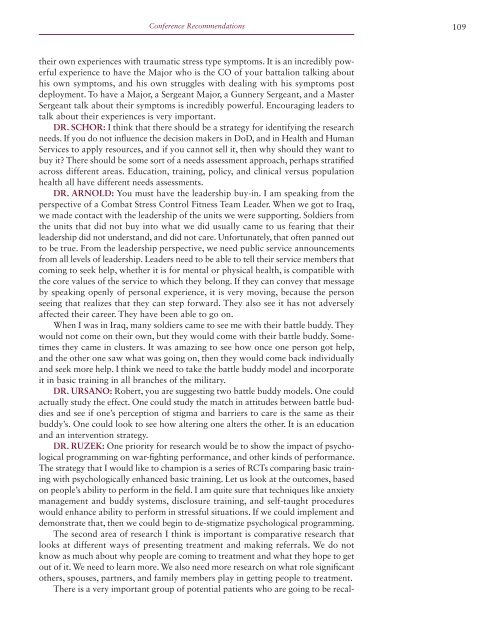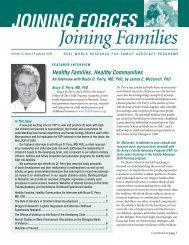stigma and barriers to care - Uniformed Services University of the ...
stigma and barriers to care - Uniformed Services University of the ...
stigma and barriers to care - Uniformed Services University of the ...
Create successful ePaper yourself
Turn your PDF publications into a flip-book with our unique Google optimized e-Paper software.
Conference Recommendations 109<br />
<strong>the</strong>ir own experiences with traumatic stress type symp<strong>to</strong>ms. It is an incredibly powerful<br />
experience <strong>to</strong> have <strong>the</strong> Major who is <strong>the</strong> CO <strong>of</strong> your battalion talking about<br />
his own symp<strong>to</strong>ms, <strong>and</strong> his own struggles with dealing with his symp<strong>to</strong>ms post<br />
deployment. To have a Major, a Sergeant Major, a Gunnery Sergeant, <strong>and</strong> a Master<br />
Sergeant talk about <strong>the</strong>ir symp<strong>to</strong>ms is incredibly powerful. Encouraging leaders <strong>to</strong><br />
talk about <strong>the</strong>ir experiences is very important.<br />
DR. SCHOR: I think that <strong>the</strong>re should be a strategy for identifying <strong>the</strong> research<br />
needs. If you do not influence <strong>the</strong> decision makers in DoD, <strong>and</strong> in Health <strong>and</strong> Human<br />
<strong>Services</strong> <strong>to</strong> apply resources, <strong>and</strong> if you cannot sell it, <strong>the</strong>n why should <strong>the</strong>y want <strong>to</strong><br />
buy it There should be some sort <strong>of</strong> a needs assessment approach, perhaps stratified<br />
across different areas. Education, training, policy, <strong>and</strong> clinical versus population<br />
health all have different needs assessments.<br />
DR. ARNOLD: You must have <strong>the</strong> leadership buy-in. I am speaking from <strong>the</strong><br />
perspective <strong>of</strong> a Combat Stress Control Fitness Team Leader. When we got <strong>to</strong> Iraq,<br />
we made contact with <strong>the</strong> leadership <strong>of</strong> <strong>the</strong> units we were supporting. Soldiers from<br />
<strong>the</strong> units that did not buy in<strong>to</strong> what we did usually came <strong>to</strong> us fearing that <strong>the</strong>ir<br />
leadership did not underst<strong>and</strong>, <strong>and</strong> did not <strong>care</strong>. Unfortunately, that <strong>of</strong>ten panned out<br />
<strong>to</strong> be true. From <strong>the</strong> leadership perspective, we need public service announcements<br />
from all levels <strong>of</strong> leadership. Leaders need <strong>to</strong> be able <strong>to</strong> tell <strong>the</strong>ir service members that<br />
coming <strong>to</strong> seek help, whe<strong>the</strong>r it is for mental or physical health, is compatible with<br />
<strong>the</strong> core values <strong>of</strong> <strong>the</strong> service <strong>to</strong> which <strong>the</strong>y belong. If <strong>the</strong>y can convey that message<br />
by speaking openly <strong>of</strong> personal experience, it is very moving, because <strong>the</strong> person<br />
seeing that realizes that <strong>the</strong>y can step forward. They also see it has not adversely<br />
affected <strong>the</strong>ir <strong>care</strong>er. They have been able <strong>to</strong> go on.<br />
When I was in Iraq, many soldiers came <strong>to</strong> see me with <strong>the</strong>ir battle buddy. They<br />
would not come on <strong>the</strong>ir own, but <strong>the</strong>y would come with <strong>the</strong>ir battle buddy. Sometimes<br />
<strong>the</strong>y came in clusters. It was amazing <strong>to</strong> see how once one person got help,<br />
<strong>and</strong> <strong>the</strong> o<strong>the</strong>r one saw what was going on, <strong>the</strong>n <strong>the</strong>y would come back individually<br />
<strong>and</strong> seek more help. I think we need <strong>to</strong> take <strong>the</strong> battle buddy model <strong>and</strong> incorporate<br />
it in basic training in all branches <strong>of</strong> <strong>the</strong> military.<br />
DR. URSANO: Robert, you are suggesting two battle buddy models. One could<br />
actually study <strong>the</strong> effect. One could study <strong>the</strong> match in attitudes between battle buddies<br />
<strong>and</strong> see if one’s perception <strong>of</strong> <strong>stigma</strong> <strong>and</strong> <strong>barriers</strong> <strong>to</strong> <strong>care</strong> is <strong>the</strong> same as <strong>the</strong>ir<br />
buddy’s. One could look <strong>to</strong> see how altering one alters <strong>the</strong> o<strong>the</strong>r. It is an education<br />
<strong>and</strong> an intervention strategy.<br />
DR. RUZEK: One priority for research would be <strong>to</strong> show <strong>the</strong> impact <strong>of</strong> psychological<br />
programming on war-fighting performance, <strong>and</strong> o<strong>the</strong>r kinds <strong>of</strong> performance.<br />
The strategy that I would like <strong>to</strong> champion is a series <strong>of</strong> RCTs comparing basic training<br />
with psychologically enhanced basic training. Let us look at <strong>the</strong> outcomes, based<br />
on people’s ability <strong>to</strong> perform in <strong>the</strong> field. I am quite sure that techniques like anxiety<br />
management <strong>and</strong> buddy systems, disclosure training, <strong>and</strong> self-taught procedures<br />
would enhance ability <strong>to</strong> perform in stressful situations. If we could implement <strong>and</strong><br />
demonstrate that, <strong>the</strong>n we could begin <strong>to</strong> de-<strong>stigma</strong>tize psychological programming.<br />
The second area <strong>of</strong> research I think is important is comparative research that<br />
looks at different ways <strong>of</strong> presenting treatment <strong>and</strong> making referrals. We do not<br />
know as much about why people are coming <strong>to</strong> treatment <strong>and</strong> what <strong>the</strong>y hope <strong>to</strong> get<br />
out <strong>of</strong> it. We need <strong>to</strong> learn more. We also need more research on what role significant<br />
o<strong>the</strong>rs, spouses, partners, <strong>and</strong> family members play in getting people <strong>to</strong> treatment.<br />
There is a very important group <strong>of</strong> potential patients who are going <strong>to</strong> be recal-




